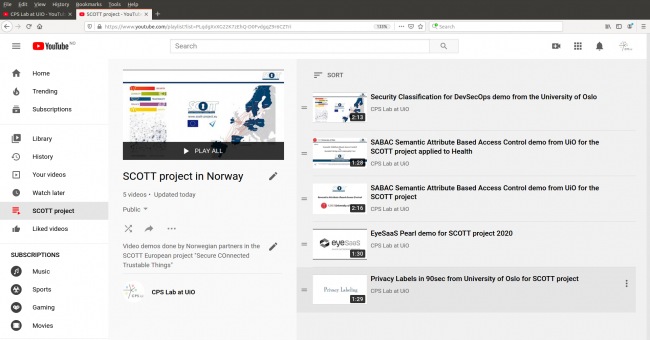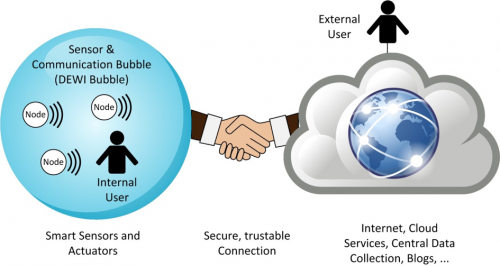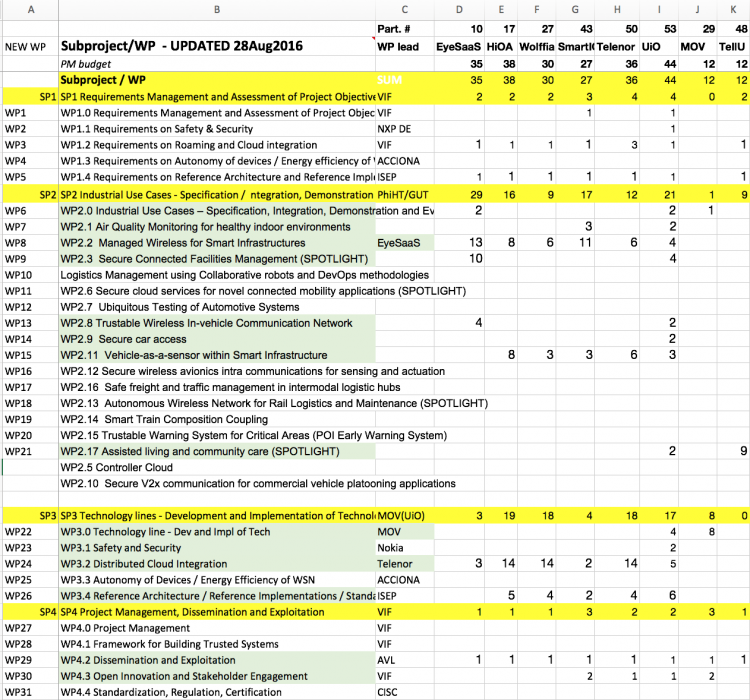SCOTT:SCOTT
From its-wiki.no
| Wiki for ITS | ||||||
|---|---|---|---|---|---|---|
|
| Project: SCOTT |
|---|
| Secure COnnected Trustable Things (ECSEL-IA 737422) |
| Web: | http://SCOTT.IoTSec.no |
|---|---|
| Project leader | Michael Kaerner |
| Project Participants | Josef Noll, Christian Johansen, Toktam Ramezanifarkhani, Linda Firveld, Jan Pedro Tumusok, Geir Arne Rimala, Do van Thanh, Do van Thuan, Paal Engelstad, Lars Thomas Bøye, Boning Feng, Heidi Tuiskula, Dieter Hirdes, Knut Eilif Husa, Bjarne Tarjei Haugen, Seraj Fayyad, Stian Løvold, Elahe Fazeldehkordi, Hai Thanh Nguyen, Weiqing Zhang, Bernardo Santos, Bruno Dzogovic, Maunya Doroudi Moghadam, Qazi Sohail Ahmad |
| Start Date | 2017/05/01 |
| End Date | 2020/09/30 |
| Supported by | NFR, JU ECSEL |
| Objective | Creating trust in wireless solutions and increasing their social acceptance are major challenges to achieve the full potential of the Internet of Things (IoT). Therefore, SCOTT – Secure COnnected Trustable Things, a pan-European effort with 57 key partners from 12 countries (EU and Brazil), will provide comprehensive cost-efficient solutions of wireless, end-to-end secure, trustworthy connectivity and interoperability (Technology Readiness Level 6-7) to bridge the last mile to market implementation. SCOTT will not just deal with 'things that are connected', but with 'trustable things that securely communicate', i.e. things interconnected by dependable wireless technology and valuing the end-users' privacy rules.
SCOTT will focus on wireless sensor and actuator networks and communication in the areas of mobility, building & home / smart infrastructure as well as health. This addresses numerous European societal challenges such as smart, green and integrated transport, secure and inclusive societies as well as health and wellbeing. SCOTT will enable efficient, trustworthy connectivity and facilitate ubiquity of intelligent embedded systems and systems of systems, thus essentially contributing to burning issues in Automated Vehicles, Industry 4.0, etc. |
| Research Domain | 5G Networks, Internet - IoPTS |
| Keywords | Wireless Sensor Networks, Wireless Communication |
Factpage of Project SCOTT
Equipment used in project: SCOTT:SCOTT/Equipment
Secure Connected Trustable Things (SCOTT)
- 3 years project, financed in part by JU ECSEL and NFR, EU-Commission Contract 737422
- 57 partners from 12 countries
- total budget of 39.7 M€, with EU support of 10.5 M€ and national support of 12.5 M€
Summary
Creating trust in wireless solutions and increasing their social acceptance are major challenges to achieve the full potential of the Internet of Things (IoT). Therefore, SCOTT – Secure COnnected Trustable Things, a pan-European effort with 57 key partners from 12 countries (EU and Brazil), will provide comprehensive cost-efficient solutions of wireless, end-to-end secure, trustworthy connectivity and interoperability (Technology Readiness Level 6-7) to bridge the last mile to market implementation. SCOTT will not just deal with 'things that are connected', but with 'trustable things that securely communicate', i.e. things interconnected by dependable wireless technology and valuing the end-users' privacy rules.
SCOTT uses a standardized multi-domain reference architecture, created in a predecessor project (DEWI and its “Bubble concept”) and being fully compliant with ISO 29182 - Sensor Network Reference Architecture, which fosters reusability, scalability, and interoperability of SCOTT solutions. SCOTT also utilizes a clearly use-case driven approach with 15 use cases from different areas of high relevance to European society and industry; a specific focus will be put on cross-domain use cases and heterogeneous environments, emphasizing 5G and cloud computing aspects to build up digital ecosystems to achieve a broader market penetration.
Tangible results from all use cases will ultimately be shown to a broader public via more than 20 demonstrators all over Europe. Use Cases will be further substantiated by the development and utilization of nearly 50 technical building blocks for security/safety, distributed cloud integration, energy efficiency/autonomy of devices and reference architecture/implementations, which are all necessary to realize the SCOTT use cases and facilitate composability of systems as well as cross-domain sharing of trustable wireless technologies and services.
The excellent partner consortium of SCOTT facilitates comprehensive vertical integration in different areas, covering the full value chain from silicon to end-users and operators. By providing reference implementations, SCOTT aims at establishing an eco-system for trustable wireless solutions and services for both professional and private users by attracting 3rd parties and particularly SMEs. This together with the involvement of open innovation approaches and stakeholder engagement as well as close cooperation with AIOTI, the Alliance for Internet of Things Innovation, and other cluster organizations all over Europe will further boost and exploit the growing “Internet economy”.
SCOTT will open up new market opportunities for the European industry, will significantly reduce time to market and decrease costs for trustable wireless solutions on the market, in particular by using new designs and technical building blocks. SCOTT will develop methods and tools capable of meeting prospect use-case requirements on reliability, robustness, security and functional safety even in harsh and/or not trusted environments. Ultimately, SCOTT will foster the European leadership for Smart and Connected Things (including Internet of Things) and will strengthen Europe’s independence for security enabling components and systems.
Norwegian Participation
From Norway 8 partners participate:
- Eye Networks with their EyeSaaS Cloud, focussing on managed Wifi for trustable services;
- OsloMet (former: HiOA) with their expertise on networking, security, and IoT;
- Movation with their innovation ecosystem, focussing on technology outview and start-up opportunities;
- NCE Smart, represented by Smart Innovation Østfold, focussing on applicability for the Norwegian Smart Grid Security Centre
- Telenor with their mobile network connecting the distributed cloud and focus on adaptable network slicing for secure and trusted IoT communications
- TellU with TelluCloud, their technology platform for data gathering, processing and presentation, focussing on applicability in domains of assisted living, e-health and personnel safety;
- UiO with their methodologies for measurable security and privacy, focussing on privacy labelling and quantifiable security for IoT systems;
- Wolffia with their industrial messaging system, focussing one security in adaptable networks.
Administrative responsible
- Telenor - Do van Thanh, m: 90977102
- Smart Innovation - Dieter Hirdes, m: +47 90550268 (project leader: Heidi Tuiskula)
- Movation - Bjarne Haugen, m: 4001 1100
- Eye Network - Tabita Hildebrandt, m: 40 200 335, m: 9159 1988 (project leader: Maghsoud Morshedi)
- OsloMet - Boning Feng, m: 9589 7687
- Tellu IoT - Lars Thomas Bøye, m: 90 57 29 29
- Wolffia - Do van Thuan, m: ??
- UiO co-ordinates Norwegian participation
SCOTT-NO Overview of Responsibilities
Highlights of Results
Many Demonstrators
The Norwegian partners recorded several videos demonstrating the different works. Some of these are available through the SCOTT playlist of the CPS Lab channel on YouTube.

Highlights in Short
Privacy Labeling - UiO
For people concerned about privacy when choosing an IoT product, Privacy Labels make it easy to do truly well informed choices. Privacy Labels look like nutrition facts labels when factual details are being presented and look like energy consumption labels when only comparing based on graded scales. Privacy Labels promote 'Privacy as an added value/feature' allowing to differentiate from market competitors. Privacy Labels are legally binding, tied to privacy agreements, so that it cannot become a means of deceit. AI and Natural Language Processing techniques are used to automatically translate between privacy agreements and privacy labels. We are working with bodies like EuroPriSe (from Germany) to enhance GDPR certifications with measurable and usable privacy, going beyond the yes/no compliance. We are working with PrivacyLabels.org (from Netherlands) who provide to privacy conscious companies a way to create privacy labels through a self-evaluation process guided by a web service. Stakeholders include Lay people, Law firms, Regulatory or Certification bodies, and Businesses.
Security Classification for DevSecOps - UiO
We have develop a security classification method for IoT systems to help and guide developers into building their systems secure from the start. At the same time we wanted to have a way for decision makers to be able to quickly evaluate and compare systems based on their security, hence the concept of a security class. The Security Classification methodology is a way to measure security, building on the standard from the French national agency ANSSI. The methodology moves away from a classical attack-centric approach, into an approach focusing on connectivity (like what ports are opened) and security protection mechanisms (like what encryption do we use).
We have build a tool and tested it with end-user to be easy-to-use in a standard DevSecOps tool-chain. This final tool, implementing the security classification methodology, is available as a cloud service to everyone at the link https://LightSC.azurewebsites.net
We have applied the security classification to the work packages 21, 9 and 7, also inside the University of Oslo in a course on IoT security, and also in a hackaton contest with a cluster of SMEs from Poland, which Gdansk University helped us to organize.
Semantic Attribute Based Access Control - UiO
We have worked on combining Attribute Based Access Control with semantic technologies, which we called semantic attribute based access control (SABAC). We are backward compatible with the XACML standard (extensible access control markup language) as describe by NIST, and widely used in healthcare systems especially in US. The final SABAC engine is accessible as a cloud service, deployed in cloud infrastructure of the University of Oslo. The architecture of our engine is closely extendind the XACML architecture. We have mainly worked with Work Packages 9 and 21 during our development, and provided two stand-alone demonstrators of SABAC for these two pilots. These videos can be found on the above CPS Lab YouTube channel. University of Oslo has collaborated on research with Chalmers University from Sweden and with Luxembourg University.
Diabetes App - Tellu
TellU as a provider of services in the e-health domain, has developed a diabetes monitoring sub-system, with mobile app serving as a gateway between medical measurement devices and cloud systems. When a patient with diabetes uses insulin, the level of glucose may decrease (hypoglycaemia) which can affect the physical and mental performance and in serious cases it can results in losing consciousness. In this situation care givers need to be alerted and be able to enter into the patient's house. TellU in collaborating with Prediktor Medical company provide a prototype device that can be worn as a patch on the skin, doing continuous glucose monitoring, called BioMKR. BioMKR does a new type of non-intrusive glucose measuring which does not need to inject anything into the body and does not collect any blood. The device is connected via Bluetooth to a phone app which is called TellU Medical Gateway app. This app works as a gateway to connect various medical measurement devices to cloud services. The gateway app also does some local processing of measurements and alerts the relevant system to notify the care giver.
Managed Wireless - EyeNetworks
EyeNetworks as the mesh managed wireless market leader is providing total solutions for access networks to Internet service providers. Existing wireless networks perform best-effort data delivery and fail to ensure quality, security and trustability of services. In SCOTT project, EyeNetworks presented a managed wireless concept in order to improve performance, security and trustability of wireless networks and services in smart infrastructure. The managed wireless platform as a cloud service being able to monitor and manage Wi-Fi access points and Internet gateways in homes and buildings remotely. In effect, Internet service providers and third-party service providers can use this platform to monitor quality of service (QoS) and manage their devices or services to perform proactive measures for improving user satisfaction while reducing their operational costs. Furthermore, the managed wireless concept can accelerate user readiness for novel services that require carrier-grade quality in smart infrastructure.
5G4IoT - Telenor-OsloMet-Wollfia
Telenor-OsloMet-Wollfia are able to enhance the smart home experience by providing network slicing in 5G networks. For instance, in the smart home for elderly people they have a fall detection system, a smart lock in the main door and a gateway to allow these devices to connect to the cellular network. Besides the smart home slice, there is a health care centre slice that all caregivers are connected to and are able to receive messages in case of any alert detection. The available caregiver who accept the message reach the house and is able to unlock the door by using a QR code and confirmation from the healthcare centre. An identity provider and management system has been added to the network infrastructure to verify the caregivers identity and eligibility to perform a task. This system is responsible to issue and manage all identities for every devices connected to the network. In order to provide network slicing they have succeeded in deploying one of the smallest 5G networks, using off the shelf and consumer available products and open-sourced software, which is located in their Secure 5G4IoT test lab.
Open Action Items
Meetings
SCOTT related Meeting(s):- Final Review Graz Jun2020 (onThis property is a special property in this wiki. 28 September 2020)
- Privacy Labelling Workshop, 12Mar2020, Oslo (onThis property is a special property in this wiki. 12 March 2020)
- SCOTT-NO meeting Feb2020 (onThis property is a special property in this wiki. 4 February 2020)
- SCOTT-NO meeting Jan2020 (onThis property is a special property in this wiki. 17 January 2020)
- SCOTT-NO meeting Nov2019 (onThis property is a special property in this wiki. 13 November 2019)
- SCOTT Y2 Review (onThis property is a special property in this wiki. 9 October 2019)
- Consortium f2f Gdansk 2019 (onThis property is a special property in this wiki. 4 June 2019)
- SWITS annual meeting of Swedish security groups (onThis property is a special property in this wiki. 3 June 2019)
- EyeNetworks Fagdag Apr2019 (onThis property is a special property in this wiki. 29 April 2019)
- Elektrofagdag OsloMet 22Mar2019 (onThis property is a special property in this wiki. 22 March 2019)
- ... further results
| Due date | 30 September 2020 + |
| Keywords | Wireless Sensor Networks + and Wireless Communication + |
| Objective | Creating trust in wireless solutions and i … Creating trust in wireless solutions and increasing their social acceptance are major challenges to achieve the full potential of the Internet of Things (IoT). Therefore, SCOTT – Secure COnnected Trustable Things, a pan-European effort with 57 key partners from 12 countries (EU and Brazil), will provide comprehensive cost-efficient solutions of wireless, end-to-end secure, trustworthy connectivity and interoperability (Technology Readiness Level 6-7) to bridge the last mile to market implementation. SCOTT will not just deal with 'things that are connected', but with 'trustable things that securely communicate', i.e. things interconnected by dependable wireless technology and valuing the end-users' privacy rules. SCOTT will focus on wireless sensor and actuator networks and communication in the areas of mobility, building & home / smart infrastructure as well as health. This addresses numerous European societal challenges such as smart, green and integrated transport, secure and inclusive societies as well as health and wellbeing. SCOTT will enable efficient, trustworthy connectivity and facilitate ubiquity of intelligent embedded systems and systems of systems, thus essentially contributing to burning issues in Automated Vehicles, Industry 4.0, etc. in Automated Vehicles, Industry 4.0, etc. + |
| Partner | NFR + and JU ECSEL + |
| Project | SCOTT:SCOTT + |
| Project Participant | Josef Noll +, Christian Johansen +, Toktam Ramezanifarkhani +, Linda Firveld +, Jan Pedro Tumusok +, Geir Arne Rimala +, Do van Thanh +, Do van Thuan +, Paal Engelstad +, Lars Thomas Bøye +, Boning Feng +, Heidi Tuiskula +, Dieter Hirdes +, Knut Eilif Husa +, Bjarne Tarjei Haugen +, Seraj Fayyad +, Stian Løvold +, Elahe Fazeldehkordi +, Hai Thanh Nguyen +, Weiqing Zhang +, Bernardo Santos +, Bruno Dzogovic +, Maunya Doroudi Moghadam + and Qazi Sohail Ahmad + |
| Project leader | Michael Kaerner + |
| Research Domain | 5G Networks + and Internet - IoPTS + |
| StartDate | 1 May 2017 + |
| Title | Secure COnnected Trustable Things (ECSEL-IA 737422) + |
| Web | http://SCOTT.IoTSec.no + |


